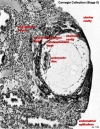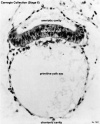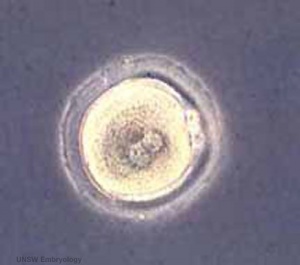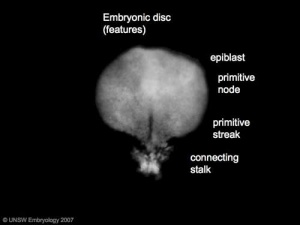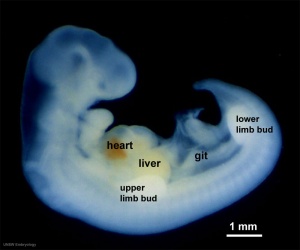Introduction
| Author Comments
|
 Start here by looking at the external appearance of embryos in sequence from 1 to 23. It is not so important to memorise the dates, as they are only approximate, but more important to understand growth (size changes) and the development (overall sequence of events) during this period. Start here by looking at the external appearance of embryos in sequence from 1 to 23. It is not so important to memorise the dates, as they are only approximate, but more important to understand growth (size changes) and the development (overall sequence of events) during this period.
Clicking the Carnegie stage numbers opens a page dedicated to describing that single stage and the associated developmental events.
|
| This page shows some key events of human development during the embryonic period of the first eight weeks (weeks 1 - 8) following fertilization. This period is also considered the organogenic period, when most organs within the embryo have begun to form.
There are links to more detailed descriptions which can be viewed in a week by week format, by the Carnegie stages or integrated into a Timeline of human development.
Online resources include: individual images of all Carnegie stages, scanning electron micrographs of the earlier stages, cross-sections showing internal structures at mid- and late-embryonic, 3D reconstructions of internal structures, animations of processes, ultrasound scans and information about abnormalites of development.
Note that there is variability in the actual timing of specific events and at the end of this period fetal development begins.
| Human Embryo - Biological definition
|
| Modern Definition
The following biological definition comes from the Australian National Health and Medical Research Council (NHMRC) discussion paper (2006).
- "human embryo means a discrete entity that has arisen from either:
- (a) the first mitotic division when fertilisation of a human oocyte by a human sperm is complete; or
- (b) any other process that initiates organised development of a biological entity with a human nuclear genome or altered human nuclear genome that has the potential to develop up to, or beyond, the stage at which the primitive streak appears;
- and has not yet reached 8 weeks of development since the first mitotic division."
This definition was also published later by the same group in 2007.[1]
Historical Definition
"The distinction between the embryonic and the fetal periods at 8 postovulatory weeks has proved valuable. It is based primarily on the probability that more than 90 percent of the more than 4,500 named structures of the adult body have appeared by that time."[2][3]
- Links: Embryonic Development | Fertilization | NHMRC paper PDF
|
|
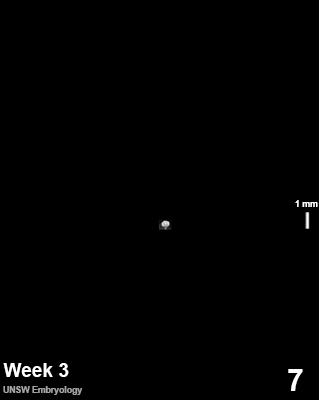
|
| Kyoto Collection
|
|
Carnegie Collection
|
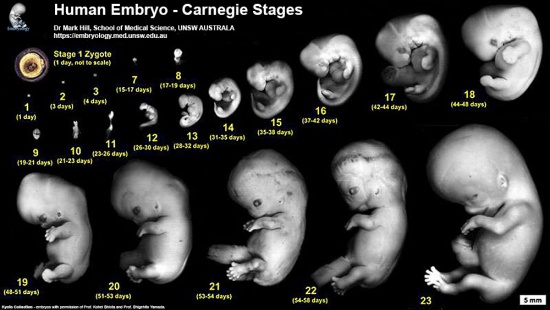
|
|
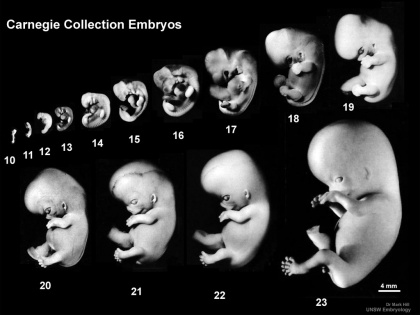
|
| Human Embryo, Carnegie stages 1-23
|
|
Human Embryo, Carnegie stages 10-23
|
Week 1
Week 2
Week 3
Week 4
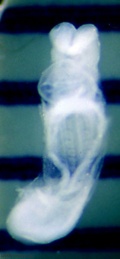
Week 4 - The heart begins
Week 5
Week 6
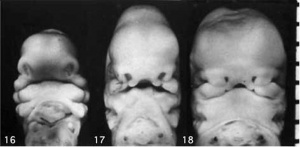
Week 6 - Early face deevelopment
Week 7

Week 7 - Head and limb development
Week 8
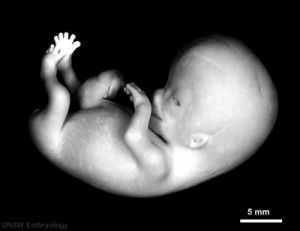
Week 8 - Last embryonic stage 23
- Week 8 - Carnegie stage - 20 | 21 | 22 | 23
- Last week of embryonic development.
- Carnegie Stages: 1 | 2 | 3 | 4 | 5 | 6 | 7 | 8 | 9 | 10 | 11 | 12 | 13 | 14 | 15 | 16 | 17 | 18 | 19 | 20 | 21 | 22 | 23 | About Stages | Timeline
Carnegie Stage Table
Weeks shown in the table below are embryonic post ovulation age, for clinical Gestational Age (GA) measured from last menstrual period, add 2 weeks.
| Stage
|
Days (approx)
|
Size (mm)
|
Images
(not to scale)
|
Events
|
| 1
|
1 (week 1)
|
0.1 - 0.15
|

|
fertilized oocyte, zygote, pronuclei
|
| 2
|
2 - 3
|
0.1 - 0.2
|

|
morula cell division with reduction in cytoplasmic volume, blastocyst formation of inner and outer cell mass
|
| 3
|
4 - 5
|
0.1 - 0.2
|

|
loss of zona pellucida, free blastocyst
|
| 4
|
5 - 6
|
0.1 - 0.2
|

|
attaching blastocyst
|
| 5
|
7 - 12
(week 2)
|
0.1 - 0.2
|

|
implantation
|
| 6
|
13 - 15
|
0.2
|

|
extraembryonic mesoderm, primitive streak, gastrulation
|
| 7
|
15 - 17 (week 3)
|
0.4
|

|
gastrulation, notochordal process
|
| 8
|
17 - 19
|
1.0 - 1.5
|

|
primitive pit, notochordal canal
|
| 9
|
19 - 21
|
1.5 - 2.5
|

|
Somitogenesis Somite Number 1 - 3 neural folds, cardiac primordium, head fold
|
| 10
|
22 - 23 (week 4)
|
2 - 3.5
|

|
Somite Number 4 - 12 neural fold fuses
|
| 11
|
23 - 26
|
2.5 - 4.5
|

|
Somite Number 13 - 20 rostral neuropore closes
|
| 12
|
26 - 30
|
3 - 5
|

|
Somite Number 21 - 29 caudal neuropore closes
|
| 13
|
28 - 32 (week 5)
|
4 - 6
|

|
Somite Number 30 leg buds, lens placode, pharyngeal arches
|
| Stage 13/14 shown in serial embryo sections series of Embryology Program
|
| 14
|
31 - 35
|
5 - 7
|

|
lens pit, optic cup
|
| 15
|
35 - 38
|
7 - 9
|

|
lens vesicle, nasal pit, hand plate
|
| 16
|
37 - 42 (week 6)
|
8 - 11
|

|
nasal pits moved ventrally, auricular hillocks, foot plate
|
| 17
|
42 - 44
|
11 - 14
|

|
finger rays
|
| 18
|
44 - 48 (week 7)
|
13 - 17
|

|
ossification commences
|
| 19
|
48 - 51
|
16 - 18
|

|
straightening of trunk
|
| 20
|
51 - 53 (week 8)
|
18 - 22
|

|
upper limbs longer and bent at elbow
|
| 21
|
53 - 54
|
22 - 24
|

|
hands and feet turned inward
|
| Stage 22 shown in serial embryo sections series of Embryology Program
|
| 22
|
54 - 56
|
23 - 28
|

|
eyelids, external ears
|
| 23
|
56 - 60
|
27 - 31
|

|
rounded head, body and limbs
|
| Following this stage Fetal Development occurs until birth (approx 37 weeks)
|
The embryos shown in the table are from the Kyoto and Carnegie collection and other sources.
References
- ↑ Findlay JK, Gear ML, Illingworth PJ, Junk SM, Kay G, Mackerras AH, Pope A, Rothenfluh HS & Wilton L. (2007). Human embryo: a biological definition. Hum. Reprod. , 22, 905-11. PMID: 17178746 DOI.
- ↑ O'Rahilly R. 1979. Early human development and the chief sources of information on staged human embryos. Europ. J. Obstet. Gynec. Reprod. Biol., 9, 273-280. PMID 400868
- ↑ O'Rahilly R. and Müller F. Developmental Stages in Human Embryos. Contrib. Embryol., Carnegie Inst. Wash. 637 (1987).
Glossary Links
- Glossary: A | B | C | D | E | F | G | H | I | J | K | L | M | N | O | P | Q | R | S | T | U | V | W | X | Y | Z | Numbers | Symbols | Term Link
Cite this page: Hill, M.A. (2024, April 27) Embryology Embryonic Development. Retrieved from https://embryology.med.unsw.edu.au/embryology/index.php/Embryonic_Development
- What Links Here?
- © Dr Mark Hill 2024, UNSW Embryology ISBN: 978 0 7334 2609 4 - UNSW CRICOS Provider Code No. 00098G
 Start here by looking at the external appearance of embryos in sequence from 1 to 23. It is not so important to memorise the dates, as they are only approximate, but more important to understand growth (size changes) and the development (overall sequence of events) during this period.
Start here by looking at the external appearance of embryos in sequence from 1 to 23. It is not so important to memorise the dates, as they are only approximate, but more important to understand growth (size changes) and the development (overall sequence of events) during this period.








